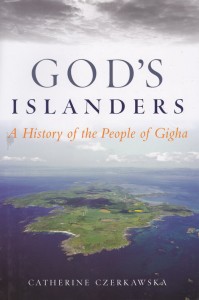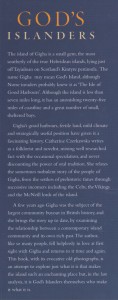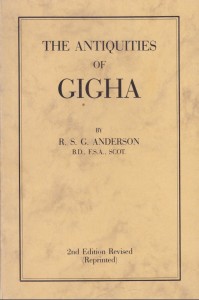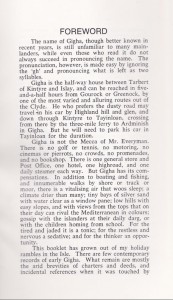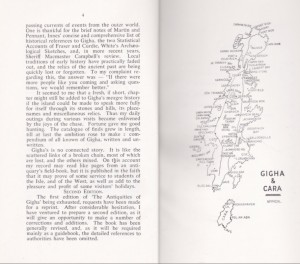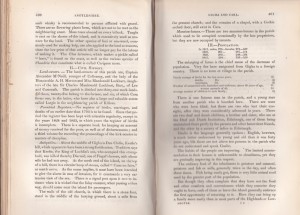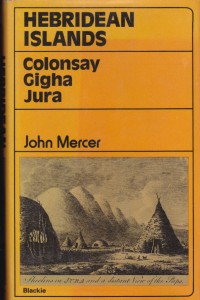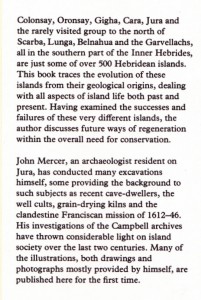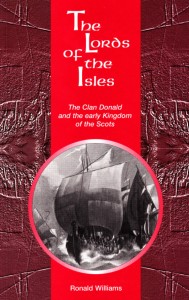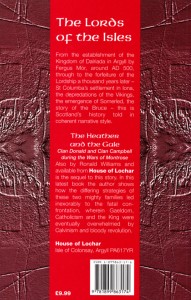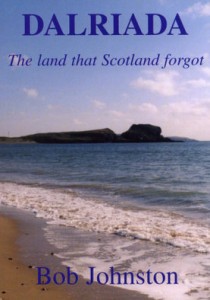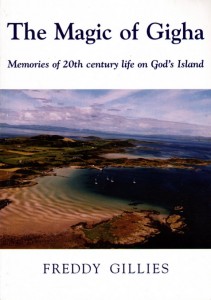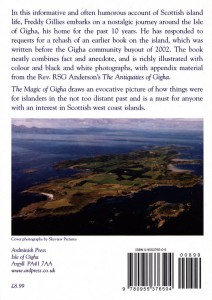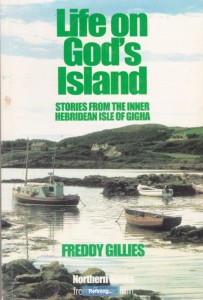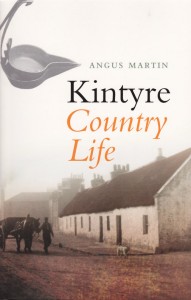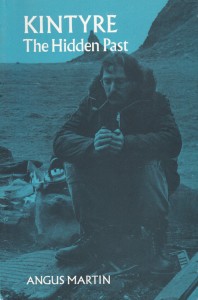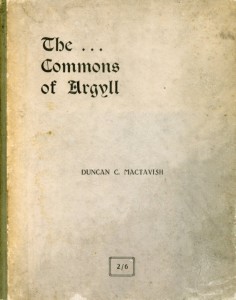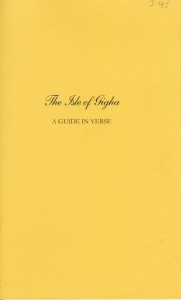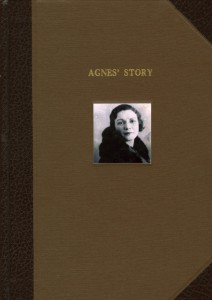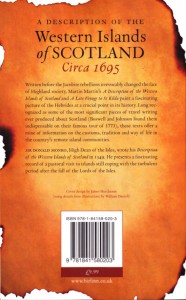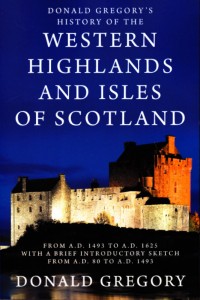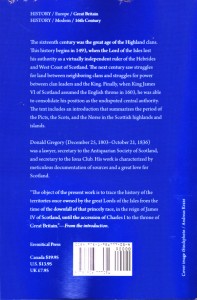There are an extraordinary number of books written about Gigha, about its people, landscape, history and lifestyle. But no matter how many you read, nothing actually prepares you for the experience of spending time on this lovely island. I can imagine no better project for myself than living on the island for a year (or more) and writing a book about its history, but others have done such a fine job already, and there is no longer a niche. Here’s my little collection. All of these publications I can highly recommend, and thank the authors for painting such a wonderful picture of life on Gigha, past and present.
Click on the images to enlarge.
I read this book shortly before my first (and only, at this point) visit to Gigha. In fact, I bought 3 copies which Catherine was kind enough to sign for me. God’s Islanders puts the Gigha of the 21st century in the context of its long history. It draws on information from other notable works on Gigha, and Catherine’s own experience and extensive background research. The chapter on the Galbraiths is particularly good. And it was great to meet some of the residents of Gigha who featured in the book, as well as visit some of the “sacred sites” so beautifully described and explained. If you can’t get it at your bookshop, amazon and sometimes ebay have copies. God’s Islanders/Amazon
I think the foreword of this classic reference book perfectly sums it up. Most other books on Gigha draw from this work. The second edition was printed in 1978. Abe Books often has a copy. I’d rather like to get a first edition copy.
- Flourishing Island Intro
This is almost a guided tour of Gigha with the legendary Betty McNeill and author Kathleen Philip. Although quite old fashioned now, it gives a great description of the island, and Kathleen has pieced together some great tales from the Kirk Sessions. Written well before the community buyout, it comes from the perspective of the Gigha of old, where every laird could herald different circumstances for the people of the island.
Ebay or Abebooks for this one.
- Page 400-401 Statistical Account
I was very fortunate to pick up this copy of Volume 16 of the Statistical Accounts of Scotland: Argyllshire.
“The ‘Old’ or ‘First’ Statistical Account of Scotland was undertaken in the 18th century under the direction of Sir John Sinclair of Ulbster (1754-1835), MP for Caithness. Known as ‘Agricultural Sir John’, he conceived a plan to ask parish ministers of the Church of Scotland all over Scotland to reply to a set of planned questions dealing with subjects such as the geography, climate, natural resources, and social customs of each parish. He defined his aim in 1790 as ‘to elucidate the Natural History and Political State of Scotland’. The returns from the parishes were published as they were received back from different parts of Scotland in a series of twenty-one volumes between 1791 and 1799.
The ‘New’ or ‘Second’ Statistical Account was suggested to the General Assembly of the Church of Scotland in 1832 by the Committee of the Society of the Sons and Daughters of the Clergy. Broadly, the ‘New’ Statistical Account followed the structure of the ‘Old’, but it also differed in that it included maps of the counties, and while the parish reports in the ‘Old’ were mostly prepared by the parish ministers, the ‘New’ Statistical Account also included contributions from other local figures such as schoolmasters and doctors. It was mostly written in the 1830s and published in fifty-two quarterly parts from 1834, culminating in being issued in 15 vol. in 1845. When it was published, the Committee presented it as ‘in great measure, the Statistical Account of a new country’.
Together, the Statistical Accounts provide vitally important reference sources for a critical half century spanning the Agricultural and Industrial Revolutions. They are locally created and factually based; the two Accounts allow comparisons to be made parish by parish at a time of rapid and significant change; and they offer a unique reference and research source for the study of local and national life in Scotland in this period.”
http://edina.ac.uk/stat-acc-scot/reading/intro.shtml
To find reports on Gigha or other parishes online: http://stat-acc-scot.edina.ac.uk/sas/sas.asp?action=public
This is a great book. It covers a long history of these 3 islands, from a brief examination of the geology, through the Neolithic and an excellent treatment of the 18th century onwards. It gives a good interpretation of the written records such as the Statistical Accounts and the comparative treatment of these islands is very insightful. Right down to the differences in appearance, character and tendencies of the inhabitants. I have found this one on Abebooks.
From the Ancient Kingdom of Dalriada to the Ruin of the Lordship, this history of the Western Isles of Scotland is sure to be of interest to anyone who sees themselves as part of the Clan Donald. Great piece of Scottish history, a thrilling read if you are interested in the story as told over many centuries. Some interesting passages about the Galbraith harper poets of Gigha. I purchased my copy from a small publishing company on Colonsay, “House of Lochar“. They carry many other titles relevant to the Isles.
I bought this book at the PO shop in Gigha on my 2008 visit, and read it on the plane on the way home. It challenged my highly romanticised notions of “McDonald”, which needed challenging! Fabulous book, a sort of “mythbusters” of Scottish history. Well written and published by Ardminish Press, a truly wonderful souvenir of my stay on the island.
Two more great books from Ardminish Press. Freddy Gillies’ tales of life on Gigha are a charming read. He tells a great story, funny guy. And his love of the island and island life pervade every page. I suspect many things about living on Gigha are timeless, Freddy brilliantly captures many such aspects.
I bought Kintyre County Life on amazon some years back and from it, really got a great glimpse of the old highland life in Argyll. It depicts ordinary aspects of the lives of ordinary people in this part of the world. Right down to stories about thatching the roof to anecdotes about individuals. My copy of “Kintyre: The Hidden Past” came from an antiquarian bookshop in a little backstreet in Campbeltown, Argyll. I think you can get later editions on amazon, but like mine, they can be expensive as it was published in 1984.
This is a very interesting book. It is a list of men’s names, copied in 1935 from the records of the Sheriff Court of Argyll at Inverary. The lists are from 1685 and 1692. As the author says ” apart from their historical connection with Argyll’s rebellion, the lists of 1692 and to a lesser extent the lists of 1695, have an interest of their own in regard to the distribution and prevelance of particular surnames”. There are lists from Gigha & Tarbert as well as the rest of Argyll. I don’t know where this can be purchased from, I can’t even remember where I got it.
This is the life story of my Grandmother, Agnes. It is her story, which I helped her write over a 10 year period. Really, it’s an aural history, with her version of events and her connections with Gigha and Tarbert. When she visited Gigha, she would visit Betty McNeill for a cuppa and long chats. She told me Betty was her cousin, although I don’t know the exact relationship. She holidayed in Tarbert throughout her life and it was there that she stayed with her aunts and cousins until her last visit in 2000.
Only a brief description of Gigha, but it gives a very distinct impression of the superstition and folklore of the “natives” despite them being protestant!
